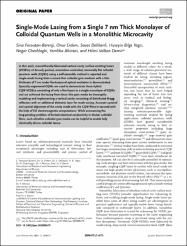| dc.contributor.author | Foroutan-Barenji, Sina | |
| dc.contributor.author | Erdem, Onur | |
| dc.contributor.author | Delikanli, Savas | |
| dc.contributor.author | Yagci, Huseyin Bilge | |
| dc.contributor.author | Gheshlaghi, Negar | |
| dc.contributor.author | Altintas, Yemliha | |
| dc.contributor.author | Demir, Hilmi Volkan | |
| dc.date.accessioned | 2022-03-01T08:01:14Z | |
| dc.date.available | 2022-03-01T08:01:14Z | |
| dc.date.issued | 2021 | en_US |
| dc.identifier.issn | 1863-8880 | |
| dc.identifier.issn | 1863-8899 | |
| dc.identifier.uri | https //doi.org/10.1002/lpor.202000479 | |
| dc.identifier.uri | https://hdl.handle.net/20.500.12573/1204 | |
| dc.description | The authors acknowledge the financial support from the Singapore National Research Foundation under the program NRF-NRFI2016-08 and in part from TUBITAK 115E679. The authors thank Mustafa Guler for his assistance in TEM imaging of the as-synthesized CQWs and preparation of the TEM cross-sectional sample, and Dr. Gokce Celik for her help on the ellipsometric measurements. O.E. acknowledges TUBITAK for the financial support through BIDEB 2211 program. H.V.D. gratefully acknowledges support from TuBA. | en_US |
| dc.description.abstract | In this work, the first account of monolithically-fabricated vertical cavity surface emitting lasers (VCSELs) of densely-packed, orientation-controlled, atomically flat colloidal quantum wells (CQWs) using a self-assembly method and demonstrate single-mode lasing from a record thin colloidal gain medium with a film thickness of 7 nm under femtosecond optical excitation is reported. Specially engineered CQWs are used to demonstrate these hybrid CQW-VCSELs consisting of only a few layers to a single monolayer of CQWs and are achieved the lasing from these thin gain media by thoroughly modeling and implementing a vertical cavity consisting of distributed Bragg reflectors with an additional dielectric layer for mode tuning. Accurate spectral and spatial alignment of the cavity mode with the CQW films is secured with the help of full electromagnetic computations. While overcoming the long-pending problem of limited electrical conductivity in thicker colloidal films, such ultrathin colloidal gain media can be helpful to enable fully electrically-driven colloidal lasers. | en_US |
| dc.description.sponsorship | National Research Foundation, Singapore NRF-NRFI2016-08
Turkiye Bilimsel ve Teknolojik Arastirma Kurumu (TUBITAK) 115E679
Turkish Academy of Sciences
European Commission | en_US |
| dc.language.iso | eng | en_US |
| dc.publisher | WILEY-V C H VERLAG GMBHPOSTFACH 101161, 69451 WEINHEIM, GERMANY | en_US |
| dc.relation.isversionof | 10.1002/lpor.202000479 | en_US |
| dc.rights | info:eu-repo/semantics/openAccess | en_US |
| dc.subject | colloidal quantum wells | en_US |
| dc.subject | liquid interface self‐ | en_US |
| dc.subject | assembly | en_US |
| dc.subject | monolithic microcavity | en_US |
| dc.subject | single‐ | en_US |
| dc.subject | mode lasing | en_US |
| dc.subject | vertical cavity surface‐ | en_US |
| dc.subject | emitting laser | en_US |
| dc.title | Single-Mode Lasing from a Single 7 nm Thick Monolayer of Colloidal Quantum Wells in a Monolithic Microcavity | en_US |
| dc.type | article | en_US |
| dc.contributor.department | AGÜ, Mühendislik Fakültesi, Malzeme Bilimi ve Nanoteknoloji Mühendisliği Bölümü | en_US |
| dc.contributor.institutionauthor | Altintas, Yemliha | |
| dc.identifier.volume | Volume 15 Issue 4 | en_US |
| dc.relation.journal | LASER & PHOTONICS REVIEWS | en_US |
| dc.relation.tubitak | 115E679 | |
| dc.relation.publicationcategory | Makale - Uluslararası - Editör Denetimli Dergi | en_US |


















